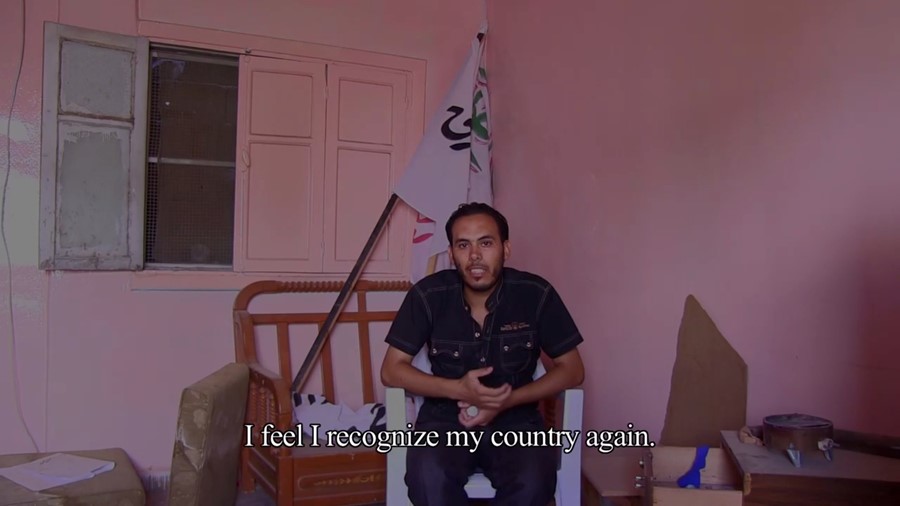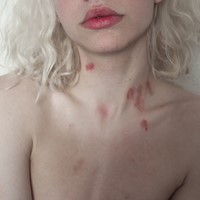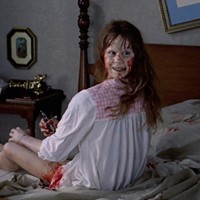One Damascus-based underground film collective is challenging conflict-ridden stereotypes with their blend of documentary and art
This Sunday it's International Peace Day, a project set up in the hope that September 21 will become an institutionally recognised day around the world. Founded back in 1999 thanks to Peace One Day and the United Nations, the aim is simple, to create "an annual day of global unity, a day of intercultural cooperation on a scale that humanity has never known". All this week we'll be raising awareness in the hope that this Sunday will be the biggest Peace Day yet. Today, we're looking at creative solutions for conflict resolution, from the Godfather of Israeli graphic design's endless battle for peace to the Syrian artist-journalists looking to document the real-life of their war-ravaged country.
In the blue dawn a man drags a hose across a mosque courtyard and begins to clean the walls and doorways. White birds fly past a minaret and settle in flocks on the freshly washed tiles. More men begin to arrive, slowly, wrapped up against the cold. Inside, a barefooted boy in faded overalls pulls a noisy vacuum cleaner over a red carpet. The camera follows him, and through his legs men can be seen quietly praying, reading and talking. The hoover is switched off, and with it, the camera. That’s it – a 4.43 minute glimpse into a calm early morning in Syria.
Every Friday for the past three years, the Damascus-based underground film collective Abounaddara – Arabic slang for a man with glasses – have uploaded short films like this onto Vimeo. They call it ‘emergency cinema’. Sent anonymously from across Syria and beyond (often the editors themselves do not know the locations), the films tell ordinary stories of everyday life that “do something to let you see and feel this society in an accurate way”, as spokesperson Charif Kiwan puts it. (The only other named member of the collective is filmmaker Osama al-Habali, who was arrested two years ago trying to re-enter Syria from Lebanon. He is still missing.)
Graphic images of the dead or injured are not allowed. By providing a different narrative to the footage of the country provided by news journalists, Abounaddara resists the well-funded social media campaigns of Islamic State and President Assad’s regime.
“If we accept the mainstream representation of the conflict in Syria we just have two actors,” Kiwan says. “A gentleman who is a dictator but he is very polite, he smiles, a very attractive guy, but he is a criminal – and the ugly jihadists. But we don’t see the society. We don’t see ordinary people. So we try to show those people who are not victims, not heroes, they just try to struggle for freedom and to live with dignity.”
Abounaddara declared these intentions from the start. “As filmmakers,” they said in an early interview with Books & Ideas, “we could not resign ourselves to seeing the images of our revolution fall into the hands of television, which has always been a major intermediary for the dictatorship in Syria and elsewhere in the Arab world.”
“That is why we decided to mobilise by tackling the issues of the revolution with film devices. We wanted to provide counter-information by making short weekly films that put forward not an alternative truth but a unique narrative that would involve the audience in a human way, far from any political or national consideration.”
Favouring close, long and static shots, the films show daily concerns; the intricate and diverse ways of living that slowly create a sense of identity. Although they may be powerless to save lives, filming intimate little scenes like this is a way of preserving the kind of collective, complex cultural memory that builds over thousands of years.
Sometimes Abounaddara pens captions for their films; one simply reads: “Man must remain human in spite of and because of everything. This is known as greater jihad.” The film simply shows an elderly man in freshly pressed, white monogrammed pajamas, peacefully overseeing general repairs to his house and garden.
The collective’s work could be called citizen journalism, but the art world has taken a keen interest too. Kiwan has recently been in New York where 12 Abounaddara videos have been exhibited as part of Here and Elsewhere, a major exhibition of contemporary art from the Arab world at the New Museum.
The films – which range from wordless scenes of daily life to multi-part confessional interviews – are well suited to exhibition, which seeks to counteract the idea of the Arab world as a cohesive entity and to question the role of the artist in the face of unfolding historical events. It is the art world’s latest attempt to contribute an understanding of the political and cultural complexities within many Arab countries; in London, the ICA is currently host to something similar (but on a much smaller scale) with Whose Gaze Is It Anyway?.
Of course, the anonymous, self-taught filmmakers of Abounaddara don’t set out to be artists. But their individual grassroots reportage grapples adeptly with the responsibility that artists, traditionally granted the status of alternative visionaries, have always known: that images can create fictions that can influence history.
Speaking recently at the American University of Beirut, Kiwan said: “We try to tell our friends, the citizen journalists we work with, that they can do things in other ways. They give us many of their images and we work with them, but we want to show them that it’s possible to deal with these images in new ways, simply because it’s necessary to convince viewers to really ask themselves if (what they’re seeing) is true or not.”
To that end, places, people and timings are kept deliberately obscure; editing is important to the process because of the disorientating mix of past and present. “We wanted to create films like bullets. We wanted to make something beautiful and violent. We want to trouble you. We want you to ask yourself who’s making this film.”
Image and news saturation can reduce the impact of a tragedy – the scale and effect becomes difficult to imagine. “But if I give you testimony,” Kiwan continued, “if you see the tragedy through the eyes of a child – for example, we filmed children telling stories about massacres – then you can feel how big the tragedy was. We can imagine, and poetry is imagination. I have a duty to give you space for imagination; we have a responsibility and a duty to always keep the largest possibility for imagination open when we show reality. It’s really very important.”
Every Friday, Abounaddara offers its glasses to the rest of the world. Seen through its lenses, the raw detail becomes clearer, authentic stories can be told and hope can be found. When the mundane and familiar becomes a fading reality that must be preserved, that is when, sadly, it becomes emergency art.
Follow the story as it develops and follow Peace One Day's latest updates here.




